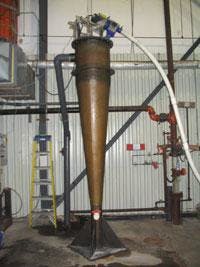New System Designed for Wastewater Neutralization
Traditional wastewater neutralization systems use large collection tanks, mixers, injectors, pH controllers, and the addition of one of many caustic or alkaline chemicals. This traditional system, though effective, has many problems associated with its use, including size of equipment, complicated PLC configurations, maintenance issues, probe calibration, employee time, and the need for and storage of hazardous chemicals.
Green Turtle Technologies Limited (GTT) has developed an innovative flow-through acidic wastewater treatment system known as PHIX. The system is designed to treat acidic wastewater in process and/or prior to discharge into a water body or municipal sewer system. The pH can be adjusted to by-law limits, or specific levels if required, resulting in the elimination of sewer surcharges or fines.
The PHIX System is unique in many ways, including its flow-through design, and its environmentally friendly media. The system has been designed to allow better control over the effluent pH, and to do so with the use of an all-natural and safe media that eliminates the need for special storage or handling. The system replaces the need for large tanks, caustic injectors and mixers, and replaces them with a very small automated system.
PHIX Systems are designed on the basis of wastewater flow and composition. Seven models are available and all are designed and named based on average treatable flow rate in US gallons per minute. This includes the PHIX-5, PHIX 10, up to the PHIX-150. The company also offers a PHIX-Mini which will perform continuous treatment below 5 gpm. Higher flow rate systems can be built as required, and units can be placed in parallel if necessary. Also available are units for gravity flow treatment and options for treating basic wastewater as well.
All models include the main reactor column; an inlet control system that controls the flow of the wastewater into the reactor column; a flow control assembly which includes a valve and flow meter; an outlet assembly; and a by-pass assembly.
The reactor column is constructed from Fiberglass Reinforced Plastic (FRP) using acid resistant resins to prevent attack from the acidic wastewater or other contaminants that can be found in wastewater.
Most systems also require an automatic feed system. This feature is composed of a specially designed hopper based on the size required, an auger and auger mount on the top of the units, and a pH transmitter built into a main control unit. The automated feature allows continuous, unmanned running of the unit, and will save money in both operational and labor costs.
Wastewater enters the system through an inlet connection at the bottom of the specially designed reactor column. A specified amount of PHIX media is in the column, where contact occurs and the chemical reaction takes place. Media is added with the automated feed system when pH values are below that required by the client.
When the wastewater reaches the top of the reactor column, its pH has been adjusted to within the required range or value, and it is ready to be discharged or used again in the process. The media is a proprietary mix of various solid alkali materials. It not a resin, and does not require regeneration, it is consumed through the process and added as required by the automated feed system.
There are several formulations of PHIX Media, and the type of product prescribed for the location is based on acid type, concentration, and what kind of contaminants are in the wastewater. Wastewater is very unique to each industry and location, so the first step in assessing the right system and media for the location is a detailed questionnaire. When the information is collected, the company's engineers are able to make a custom proposal to that specific location.

